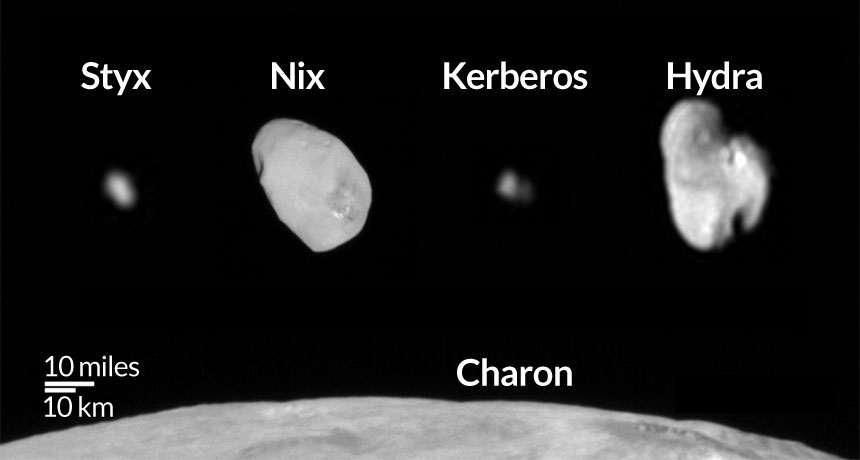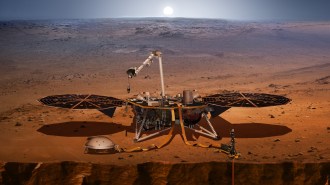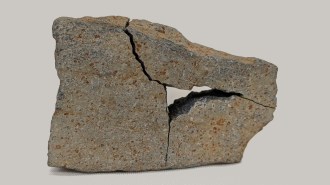Pluto’s smaller moons pose mysteries
New Horizon images offer clues to dwarf planet’s history

FAMILY PORTRAIT The five moons of Pluto show diverse sizes, shapes and surfaces that tell the story of how this system formed and evolved.
NASA, JHU-APL, SWRI
- More than 2 years ago
Pluto and Charon might have been the stars of the New Horizons mission, but the dwarf planet’s four smaller moons have some surprises to share as well.
With images of Kerberos transmitted from the spacecraft on October 20, the Pluto family portrait is complete. The tiny moons Nix, Hydra, Kerberos and Styx are no longer pinpricks of light but textured, misshapen balls of ice that look quite different from both Pluto and Charon.
“It’s really cool that the Pluto system has all these different things,” says project scientist Hal Weaver of the Johns Hopkins University Applied Physics Laboratory in Laurel, Md. With data from the four moons, “we can put together a more complete picture of how the system formed and evolved over time.”
Three of the moons — and possibly all four — appear to have been assembled from two smaller bodies squished together. Images of Kerberos in particular are reminiscent of early pictures of comet 67P/Churyumov–Gerasimenko taken by the Rosetta spacecraft. The two lobes of 67P were probably once separate comets that gently collided and stuck (SN: 10/31/15, p. 17). Kerberos and its siblings might have a similar history.
A long-ago collision could have split proto-Pluto into Pluto and Charon, with the smaller satellites assembling out of the debris. Theorists, however, have trouble figuring out how to make that scenario work. “It’s a little bit mysterious how the four moons got there,” says Mark Showalter, a planetary scientist at the SETI Institute in Mountain View, Calif., who discovered Kerberos and Styx several years after New Horizons launched.
All four moons are tiny. Hydra — the largest — measures just 55 kilometers along its long axis; teeny Kerberos spans only 12 kilometers. Most of the sizes and even the elongated shapes were deduced ahead of New Horizons’ arrival by watching reflections change on their surfaces with the Hubble Space Telescope. “We were pretty much dead on,” says Showalter.
One surprise is how reflective the moons are. All four bounce back roughly half of the sunlight that reaches them. “My own gut tells me that we’re seeing water ice surfaces,” Weaver says. Ice in the outer solar system isn’t surprising, but how the ice has remained so clean for 4.6 billion years is puzzling. Interplanetary gunk should collect on the moons and darken the ice. Pluto’s bright moons aren’t alone in this regard; some of the icy moons of Saturn, for example, are also brighter than expected. “We don’t really have an answer to that yet,” Showalter says.
The moons are also surprisingly smooth. After billions of years of running into debris, “craters and nothing but craters is all you would see,” Showalter says. But the small moons show very few (if any) craters, which means the surfaces are relatively young.
One idea is that each impact kicks up a cloud of dust that falls back on the moon, covering up the crater that just formed. “You end up with a process where you create one crater, but you cover as many as you create,” he says.
Of all the moons, Kerberos might be the most surprising. Before New Horizons showed up, researchers used the Hubble telescope to track the movement of the moons and estimate their masses. Kerberos appeared to be too massive for so faint an object. If the mass were right, and all the moons were roughly the same density and reflect about the same amount of sunlight, then Kerberos should be about eight times as bright as it appeared from Hubble.
To get around this conundrum, Showalter, along with planetary scientist Douglas Hamilton of the University of Maryland in College Park, suggested that maybe Kerberos was much darker than the other moons (SN: 7/11/15, p. 10). New Horizons showed, however, that that it’s just as reflective as its neighbors.
The moral of the story, Showalter says, is that they probably got the mass of Kerberos wrong. “It’s a tricky business, weighing a moon.” Alternatively, Kerberos could be packed together more tightly than its brethren, but it would have to be 20 times as dense. “That seems highly unlikely,” Weaver says.
All of the best images of the small moons have been downloaded, but there are more to come. Complex compositional data is still onboard New Horizons, and researchers have only begun analyzing the images. “This is science on the edge,” Showalter says. “There are more surprises in store.”
Editor’s Note: This story was updated November 5, 2015, to correct Kerberos’ size. The moon is 12 kilometers long, not 7 kilometers.







